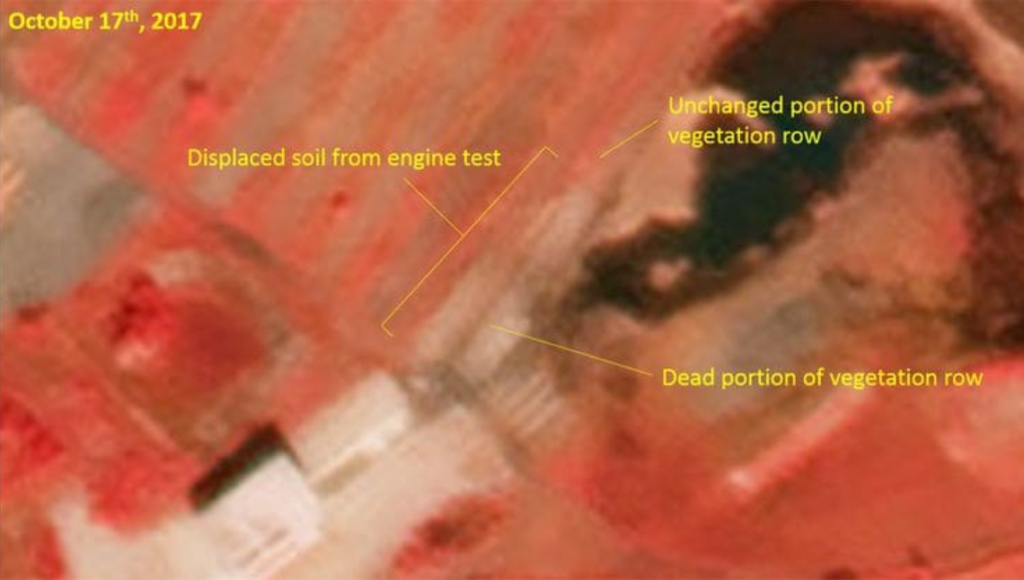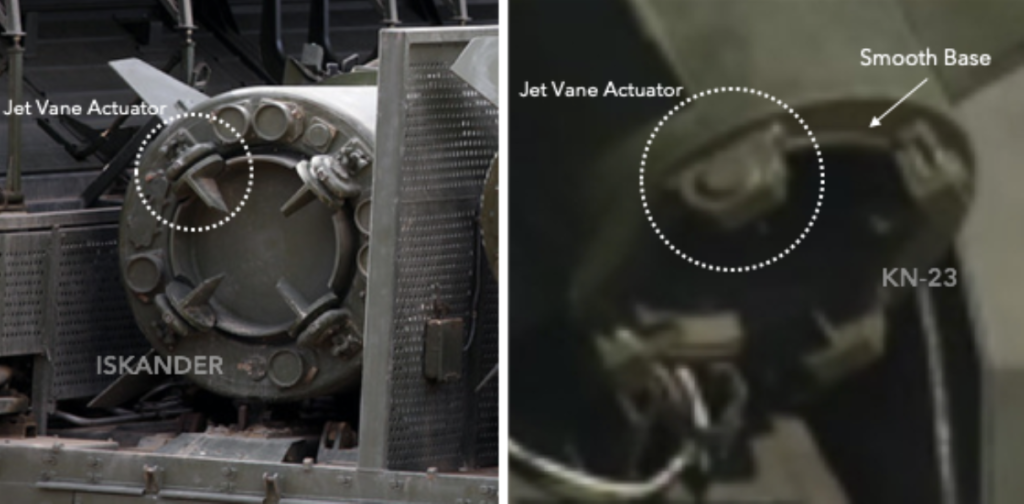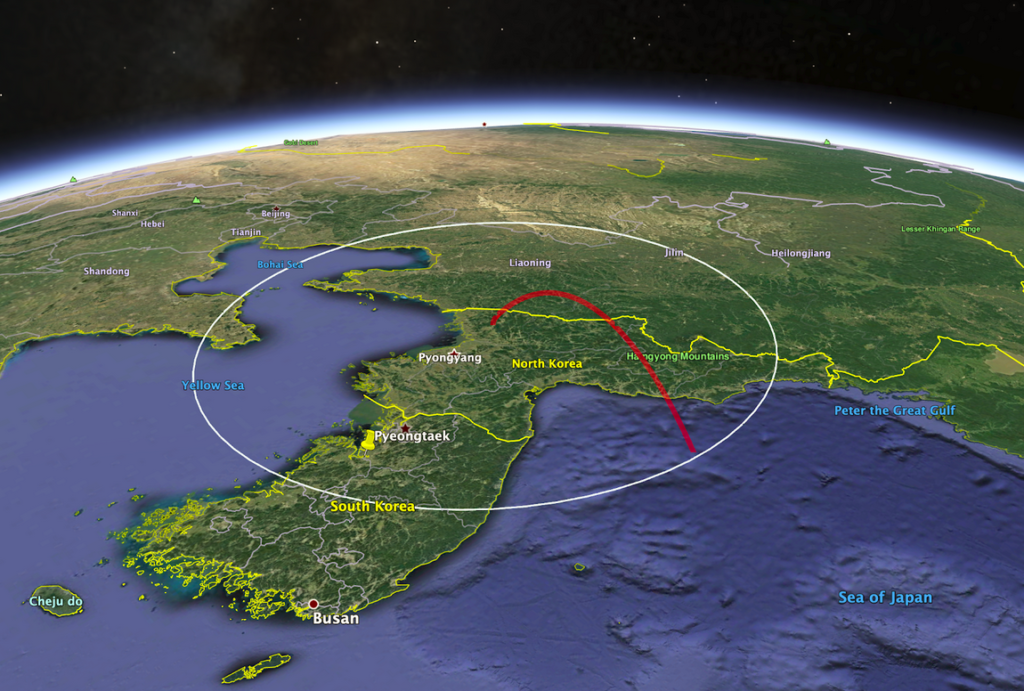Preliminary Analysis: KN-23 SRBM


 June 5, 2019
June 5, 2019
Jeffrey Lewis
North Korea has tested a new short-range ballistic missile called the KN-23 that can deliver a nuclear weapon-sized payload to targets throughout much of South Korea.
This missile is similar in capability to Russia’s Iskander-M, which flies on a quasi-ballistic trajectory designed to defeat missile defenses.
Despite the general similarity between the Iskander-M and the KN-23, the KN-23 exhibits differences consistent with indigenous design and production.
On May 4, North Korea conducted what it
described as a “firepower strike drill” that included the launch of several “large-caliber long-range multiple rocket launchers” and at least one “tactical guided weapon” that appeared to be a new short-range ballistic missile. A commercial satellite image provided by Planet Labs confirmed the launch of a missile at 10:54 am.
On May 9, North Korea conducted
a second “firepower strike drill” with “various long-range strike means,” including two short-range ballistic missiles visually identical to the one pictured on May 4.

Left: SRBM launched on May 4; right: SRBM launched on May 9. Image credits: Rodong Sinmun.
North Korea exhibited this short-range ballistic missile (SRBM) for the first time in a
parade on February 8, 2018. The United States
calls this missile the KN-23. Using parade photographs, CNS estimates the diameter of the missile’s solid rocket motor to be between 0.9 and 1.0 m—similar to that of Russia’s Iskander-M SRBM. The parade items match the missiles fired on May 4 and May 9, although different transporter -erector-launchers were employed on each of these three occasions, including a tracked launcher on May 9.
This missile may have been tested in an
unannounced static engine test near Hamhung in in mid-October 2017.
Infrared satellite images examined by CNS show a large burn scar appeared the week prior to October 17, consistent with the published date of the test.

Near infrared image of the static motor test site showing a burn scar from a possible KN-23 static motor test. Image credit: October 17, 2017, Planet Labs Inc. cc-by-sa 4.0
The KN-23 is a ballistic missile, although it is designed to fly a depressed trajectory (sometimes described as quasi-ballistic or aero-ballistic) that shortens its flight time, allows it to fly under the view of some radars, and enhances its ability to maneuver. The reported range and apogee of three missiles launched by North Korea are roughly consistent with those of the Iskander-M, which has a range of
400 km and flies a quasi-ballistic trajectory with
an apogee of 50 km.
Time, Range and Apogee of KN-23 Flights
Time (KST) Range (km) Apogee (km)
10:54 am, May 4, 2019 240 60
4:29 pm, May 9. 2019 420 50
4:39 pm, May 9, 2019 270 50
This information was provided by the ROK Joint Chiefs of Staff, as reported by Yonhap. “Defense ministry calls on N. Korea to halt tension-sparking acts,” Yonhap,
May 7, 2019; Oh Seok-min “(5th LD) N. Korea fires two short-range missiles: JCS,” Yonhap,
May 9, 2019.
Many observers have noted visual similarities between the new missile and other solid-propellant missiles. The KN-23 is similar in size and shape to Russia’s Iskander-M. However, a close analysis of the missile’s externally visible components, including the cable raceway and the actuators used to control the jet vanes, show differences from the Iskander-M (See inset).
The elongated cable raceway is unusual as it extends up into the conical section of the missile that houses the guidance and payload sections. Typically, a cable raceway runs from the bottom of the solid rocket motor to the top. The most likely explanation is that the guidance system is forward of a payload with a fixed diameter that the cabling must bypass externally, such as a nuclear warhead. The KN-23 may, therefore, be a designed as a dual-capable system of delivering conventional and nuclear payloads.
The base of the two missiles also show significant differences in the actuators and jet vanes used to steer the missile. Overall, the KN-23 appears to be indigenous, although its design appears to have been inspired by the Iskander-M and other, similar missiles, such as South Korea’s Hyunmu-2B.
Comparing the Iskander-M and the KN-23

Left: Russia’s Iskander-M with the cable raceway visible; right: The cable raceway on the KN-23 extends further up the missile, possibly suggesting a wide payload such as a nuclear warhead.

Left: The base of Russia’s Iskander-M missile showing the jet vanes and the associated actuators; Right: the base of the KN-23 shows significant differences.

Preliminary range assessment of the KN-23 using Missile Tool Kit and Missile Flyout.
Forensic analysis of the images using Tungstène, a software program that reveals the mathematical artifacts of digital alterations to images, shows that some images have been altered. These changes appear either to be cosmetic or efforts to protect sensitive information; they do not appear to alter the details of the missiles themselves.
North Korea appears to have tested the missile to a range of 420 km. Initial modeling of the missile’s performance using three programs—AGI’s Missile Tool Kit, Missile Flyout, and a CNS-developed program—suggests that it should be able to deliver a 500 kg payload to approximately a maximum range of about 450 km on a minimum energy trajectory. This result is comparable to the Iskander-M, as well the design goal for Ukraine’s
Grom. This would be sufficient to deliver a conventional or nuclear payload to most targets in South Korea, including the US military hub at Pyongtaek.
Estimated Parameters of the KN-23
Diameter (meters) 0.95
Length (meters) 7.5
Total Mass (kilograms) 3,415
Fuel Mass (kilograms) 2,530
Dry Mass (kilograms) 835
Nozzle area (square meters) 0.3
Burn time (seconds) 36
Specific Impulse (ISP) 264
Thrust (kilonewtons) 180
Payload (kilograms) 500
A computer rendering of the KN-23. (
KN-23 by
JamesMartinCNS on
Sketchfab)
The model contains significant uncertainties, although it largely agrees with the observed performance of the missile. These uncertainties stem from the challenge in measuring the dimensions of the missile and estimating the mass of the fuel, airframe, and payload. The range is sensitive to relatively small differences, on the order of 100 kg. For example, shifting 100 kilograms of mass from deadweight to fuel increases the range by about 15 percent. Additional data, including video of the missile accelerating, could reduce these uncertainties.
The flight test of this missile does not violate North Korea’s
voluntary April 2018 moratoriumon intermediate-range (IRBM) and intercontinental-range missile (ICBM) tests. North Korea did not define intermediate-range missiles, but the moratorium is understood to apply to the 4,500 km-range Hwasong-12 IRBM, as well as the much longer-range Hwasong-14 and Hwasong-15 ICBMs.
The flight test does, however, violate several UN Security Council resolutions including
UNSCR 1695 and
UNSCR 1718. UNSCR 1718 “demands that the DPRK not conduct any further nuclear test or launch of a ballistic missile.”
Some South Korean officials believe that the test violates the
September 2018 inter-Korean military agreement under which the parties “agreed to completely cease all hostile acts against each other in every domain ….” The agreement does not, however, mention missile launches, although it is specific in many other areas. For example, it prohibits live-fire artillery drills within 5 kilometers of the Military Demarcation Line (MDL).

















